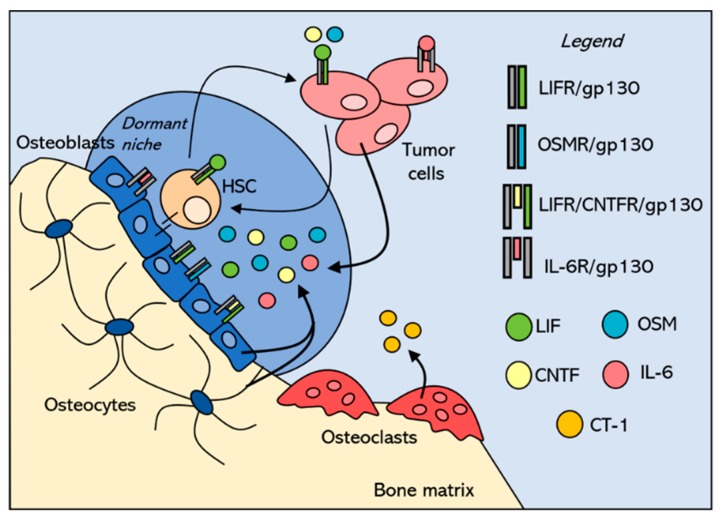Figure 2.
Bone-disseminated tumor cells compete with hematopoietic stem cells (HSCs) in the endosteal niche, where they encounter pro-dormancy cytokines in the microenvironment. Tumor cells that disseminate into the bone marrow are proposed to compete with HSCs for the endosteal niche, which maintains dormancy through cell–cell interactions and secreted factors, including the gp130 cytokines. These cytokines normally send pro-dormancy signals to the HSCs to maintain their quiescence, and when tumor cells compete for this niche, are likely to encounter the same cytokine milieu. Both HSCs and breast cancer cells express LIFR, although LIFR is markedly down-regulated in more aggressive breast cancer cells This suggests that both HSCs and breast cancer cells are capable of responding to LIF, OSM, and CNTF secreted within the bone marrow microenvironment. The sources of these cytokines in the pro-dormancy niche are bone-lining osteoblasts and osteocytes embedded within the bone matrix. Osteoclasts do not express most of the gp130 cytokines, but do express CT-1, which can also bind to LIFR. It is unclear how this might contribute to the pro-dormancy niche along the quiescent osteoblast-lined surface. LIF = leukemia inhibitory factor, OSM = oncostatin M, CNTF = ciliary neurotrophic factor, CT-1 = cardiotrophin-1, IL-6 = interleukin-6, gp130 = glycoprotein130 co-receptor, LIFR = leukemia inhibitory factor (LIF) receptor, OSMR = oncostatin M (OSM) receptor, CNTFR = ciliary neurotrophic factor (CNTF) receptor, and IL-6R = interleukin-6 (IL-6) receptor.

